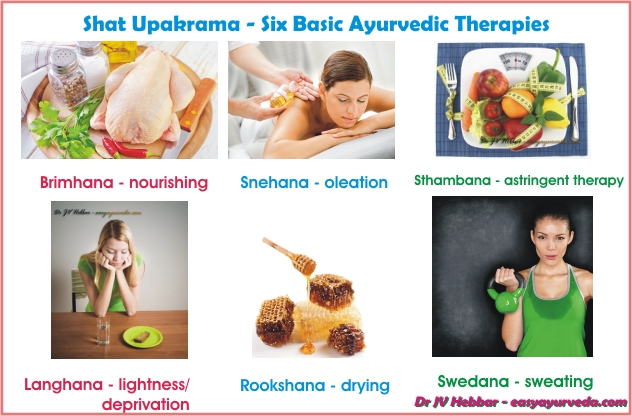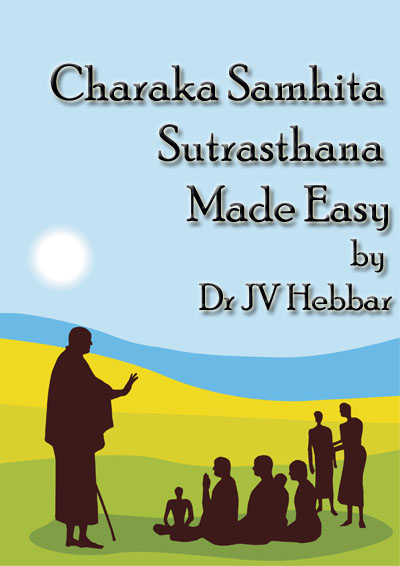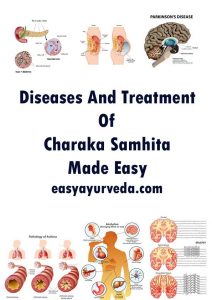Six Basic Ayurvedic Therapies – Shat Upakrama – Charaka Sutrasthana 22
Langhana – De-nourishing, or deprivation therapy and Brimhana – nourishing therapy – these two types, along with four others, form the basis of Ayurvedic therapies. This not only is applicable to weight loss or weight gain treatments. This is applicable to a plenty of diseases in Ayurveda. This concept is very impressively explained in Langhana Brimhaneeya Adhyaya, 22nd chapter of Charaka Samhita Sutrasthana.

Table of Contents
Six main Therapies of Ayurveda
लङ्घनं बृंहणं काले रूक्षणं स्नेहनं तथा|
स्वेदनं स्तम्भनं चैव जानीते यः स वै भिषक्||४||
laṅghanaṃ bṛṃhaṇaṃ kāle rūkṣaṇaṃ snehanaṃ tathā|
svedanaṃ stambhanaṃ caiva jānīte yaḥ sa vai bhiṣak||4||
With a view to initiating discussion, Lord Atreya spoke to his six illustrious disciples headed by Agnivesa (the other five are – Bhela, Harita, Ksharaparni, Jatukarna and Parashara)., who are engaged in penance and studies.
The Vaidya (doctor) is the one, who knows about
Langhana – deprivation treatment
Brimhana – nourishing therapy
Rookshana – Drying treatment
Snehana – oiling / oleation therapy
Svedana – sweating treatment
Stambhana – blocking/ stopping treatment, astringent therapy
Definitions
यत् किञ्चिल्लाघवकरं देहे तल्लङ्घनं स्मृतम्||९||
बृहत्त्वं यच्छरीरस्य जनयेत्तच्च बृंहणम्|
रौक्ष्यं खरत्वं वैशद्यं यत् कुर्यात्तद्धि रूक्षणम्||१०||
स्नेहनं स्नेहविष्यन्दमार्दवक्लेदकारकम् |
स्तम्भगौरवशीतघ्नं स्वेदनं स्वेदकारकम्||११||
स्तम्भनं स्तम्भयति यद्गतिमन्तं चलं ध्रुवम्|
yat kiñcillāghavakaraṃ dehe tallaṅghanaṃ smṛtam||9||
bṛhattvaṃ yaccharīrasya janayettacca bṛṃhaṇam|
raukṣyaṃ kharatvaṃ vaiśadyaṃ yat kuryāttaddhi rūkṣaṇam||10||
snehanaṃ snehaviṣyandamārdavakledakārakam |
stambhagauravaśītaghnaṃ svedanaṃ svedakārakam||11||
stambhanaṃ stambhayati yadgatimantaṃ calaṃ dhruvam|
Langhana – This word is derived from Laghu (lightness). Whatever the procedures or medicines that bring about lightness in the body are called Langhana – Deprivation treatment.
Brimhana – Brimhana is derived from brihat (big). Whatever causes improvement in body size/weight or causes nourishment of the body, is called Brimhana – nourishing treatment.
Rookshana – Rooksha means dry. Treatment that causes / increases Raukshya (dryness), Kharatva (roughness) and Vaishadya (clarity, non-sliminess), is called Rookshana – drying treatment.
Snehana – Whatever causes unctuousness / oiliness (Sneha), fluidity (Vishyanda), softness (Mardava) and moistness (Kleda) is Snehana or Oleation Therapy.
Swedana – whatever cures stiffness (Stambha), heaviness (Gaurava) and coldness (Sheeta) is ‘Swedana’ or Sweating Therapy.
Sthambhana – The therapy that prevents mobility and flow of bodily substances and fluids is known as ‘Stambhana’ or Astringent Therapy.
Qualities of each therapies
लघूष्णतीक्ष्णविशदं रूक्षं सूक्ष्मं खरं सरम्||१२||
कठिनं चैव यद्द्रव्यं प्रायस्तल्लङ्घनं स्मृतम्|
गुरु शीतं मृदु स्निग्धं बहलं स्थूलपिच्छिलम्||१३||
प्रायो मन्दं स्थिरं श्लक्ष्णं द्रव्यं बृंहणमुच्यते|
रूक्षं लघु खरं तीक्ष्णमुष्णं स्थिरमपिच्छिलम्||१४||
प्रायशः कठिनं चैव यद्द्रव्यं तद्धि रूक्षणम्|
द्रवं सूक्ष्मं सरं स्निग्धं पिच्छिलं गुरु शीतलम्|
प्रायो मन्दं मृदु च यद्द्रव्यं तत्स्नेहनं मतम्||१५||
उष्णं तीक्ष्णं सरं स्निग्धं रूक्षं सूक्ष्मं द्रवं स्थिरम्|
द्रव्यं गुरु च यत् प्रायस्तद्धि स्वेदनमुच्यते||१६||
शीतं मन्दं मृदु श्लक्ष्णं रूक्षं सूक्ष्मं द्रवं स्थिरम्|
यद्द्रव्यं लघु चोद्दिष्टं प्रायस्तत् स्तम्भनं स्मृतम्||१७||
laghūṣṇatīkṣṇaviśadaṃ rūkṣaṃ sūkṣmaṃ kharaṃ saram||12||
kaṭhinaṃ caiva yaddravyaṃ prāyastallaṅghanaṃ smṛtam|
guru śītaṃ mṛdu snigdhaṃ bahalaṃ sthūlapicchilam||13||
prāyo mandaṃ sthiraṃ ślakṣṇaṃ dravyaṃ bṛṃhaṇamucyate|
rūkṣaṃ laghu kharaṃ tīkṣṇamuṣṇaṃ sthiramapicchilam||14||
prāyaśaḥ kaṭhinaṃ caiva yaddravyaṃ taddhi rūkṣaṇam|
dravaṃ sūkṣmaṃ saraṃ snigdhaṃ picchilaṃ guru śītalam|
prāyo mandaṃ mṛdu ca yaddravyaṃ tatsnehanaṃ matam||15||
uṣṇaṃ tīkṣṇaṃ saraṃ snigdhaṃ rūkṣaṃ sūkṣmaṃ dravaṃ sthiram|
dravyaṃ guru ca yat prāyastaddhi svedanamucyate||16||
śītaṃ mandaṃ mṛdu ślakṣṇaṃ rūkṣaṃ sūkṣmaṃ dravaṃ sthiram|
yaddravyaṃ laghu coddiṣṭaṃ prāyastat stambhanaṃ smṛtam||17||
Characteristic features of drugs
Therapy. Characteristic Features of Drugs
1. Langhana or Lightening Therapy – Light (Laghu), hot (Ushna), sharp (Teekshna), non-slimy (Vishada), dry (rooksha), minute (sookshma), rough (khara), mobility (Sara) and hardness (Katina)
2. Brimhana or Nourishing Therapy – Heavy (Guru), cold (Sheeta), soft (Mrudu), unctuous (Snigdha), thick (Sthoola), bulky (bahala) , sticky (Picchila), sluggish (Manda), stable (sthira), and smooth (Shlakshna).
3. Rookshana or Drying Therapy – Dry (rooksha), light (laghu), rough (Khara), sharp (teekshna), hot (ushna), stable (sthira), non-non sticky (Apicchila) and hard (Katina).
4. Snehana or Oleation Therapy – Liquid (Drava), minute (Sookshma), fluid (Sara), oily (snigdha), slimy (picchila), heavy (Guru), cold (Sheeta), sluggish (manda) and soft (mridu).
5. Swedana or Fomentation Therapy – Hot (ushna), Sharp (teekshna), fluid (sara), oily (snigdha) / rough (dry), subtle (minute), liquid (drava), stable (sthira), and heavy (guru).
6. Stambhana or Astringent Therapy – Cold (sheeta), sluggish (manda), soft (mrudu), smooth (shlakshna), rough (rooksha), subtle (sookshma), liquid (drava), stable (sthira) and light (laghu).
10 types of Langhana
10 Types of Langhana Therapy (depriving / de-nourishing therapy):
चतुष्प्रकारा संशुद्धिः पिपासा मारुतातपौ|
पाचनान्युपवासश्च व्यायामश्चेति लङ्घनम्||१८||
catuṣprakārā saṃśuddhiḥ pipāsā mārutātapau|
pācanānyupavāsaśca vyāyāmaśceti laṅghanam||18||
The four types of Panchakarma purifying therapies – Vamana (emesis), Virechana (purgation), Niruha basti (decoction enema) and Nasya (nasal instillation)
Pipasa – controlling thirst
Maruta – exposure to wind
Atapa – exposure to sun
Pachana – administration of digestive foods and medicine
Upavasa – fasting
Vyayama – physical exercise constitutes Langhana Therapy. [18]
Langhana indications
Indication for ten types of Langhana therapies:
1-4 Indication for four types of Panchakarma procedures:
प्रभूतश्लेष्मपित्तास्रमलाः संसृष्टमारुताः|
बृहच्छरीरा बलिनो लङ्घनीया विशुद्धिभिः||१९||
prabhūtaśleṣmapittāsramalāḥ saṃsṛṣṭamārutāḥ|
bṛhaccharīrā balino laṅghanīyā viśuddhibhiḥ||19||
4 Panchakarma therapies as deprivation treatment is useful in
Prabhuta Shleshma, Pitta Asra – person having Kapha Pitta imbalance and blood vitiation
Prabhuta mala, Samsrushta Maruta – in person with excess toxicity / waste products in the body, in person where Vata is obstructed.
Brihat shareera – obesity
Balina – strong person
Pachana indications
5. Indication for Pachana (digestive) treatment –
येषां मध्यबला रोगाः कफपित्तसमुत्थिताः|
वम्यतीसारहृद्रोगविसूच्यलसकज्वराः||२०||
विबन्धगौरवोद्गारहृल्लासारोचकादयः|
पाचनैस्तान् भिषक् प्राज्ञः प्रायेणादावुपाचरेत्||२१||
yeṣāṃ madhyabalā rogāḥ kaphapittasamutthitāḥ|
vamyatīsārahṛdrogavisūcyalasakajvarāḥ||20||
vibandhagauravodgārahṛllāsārocakādayaḥ|
pācanaistān bhiṣak prājñaḥ prāyeṇādāvupācaret||21||
Madhya bala roga – in diseases with moderate strength,
Kapha Pitta Samutha – diseases with Kapha and Pitta imbalance, vomiting (Chardi), diarrhoea (Atisara), heart diseases (Hrit Roga), cholera (visuchika), severe kind of digestive disorder (Alasaka), fever (Jwara), constipation (vibandha), heaviness of the body (gaurava), eructation (udgara), nausea (hrullasa) and anorexia (aruchi).
Kshut trishna nigraha indications
6,7 – Indication for control of thirst and fasting :
If the same above diseases are of mild nature, they are to be treated by the control of thirst and hunger (fasting).
Vyayama, Atapa, Maruta indications
8-10 – Indication for exercise, sun and wind exposure:
If strong individuals suffer from diseases of moderate nature, such diseases can be cured by physical exercise and exposure to sun and wind. It goes without saying that diseases of mild nature of these individuals can also be cured by the same devices.
Langhana for Vata disorders
Indication for Langhana therapy even for Vata disorders:
त्वग्दोषिणां प्रमीढानां स्निग्धाभिष्यन्दिबृंहिणाम्|
शिशिरे लङ्घनं शस्तमपि वातविकारिणाम्||२४||
tvagdoṣiṇāṃ pramīḍhānāṃ snigdhābhiṣyandibṛṃhiṇām|
śiśire laṅghanaṃ śastamapi vātavikāriṇām||24||
As we have seen above, Langhana is more suited for Kapha-Pitta imbalance disorders. However, it is suited in Vata disorders also.
Tvak Dosha – skin diseases
Prameha – urinary tract disorders
Snigdha, Abhishyanda – those having excess oiliness, fluidity
Brimhana – excessively nourished body
Shishire – during the winter [19-24]
Brimhana (nourishing therapy)
non veg foods that have nourishing qualities:
अदिग्धविद्धमक्लिष्टं वयस्थं सात्म्यचारिणाम्|
मृगमत्स्यविहङ्गानां मांसं बृंहणमुच्यते||२५||
adigdhaviddhamakliṣṭaṃ vayasthaṃ sātmyacāriṇām|
mṛgamatsyavihaṅgānāṃ māṃsaṃ bṛṃhaṇamucyate||25||
Fresh meat of young animals, fishes and birds moving in their natural surroundings and killed by non-poisonous devices like arrows, etc. is nourishing.
Brimhana Indications
Indication for Brimhana (nourishing therapy) –
क्षीणाः क्षताः कृशा वृद्धा दुर्बला नित्यमध्वगाः|
स्त्रीमद्यनित्या ग्रीष्मे च बृंहणीया नराः स्मृताः||२६||
शोषार्शोग्रहणीदोषैर्व्याधिभिः कर्शिताश्च ये|
तेषां क्रव्यादमांसानां बृंहणा लघवो रसाः||२७||
kṣīṇāḥ kṣatāḥ kṛśā vṛddhā durbalā nityamadhvagāḥ|
strīmadyanityā grīṣme ca bṛṃhaṇīyā narāḥ smṛtāḥ||26||
śoṣārśograhaṇīdoṣairvyādhibhiḥ karśitāśca ye|
teṣāṃ kravyādamāṃsānāṃ bṛṃhaṇā laghavo rasāḥ||27||
Ksheena – debilitated, having muscle wasting
Kshata – injured
Krusha – emaciated patients
Vruddah – elderly patients
Durbala – weak
Nityam adhwaga – who walk excessively on a daily basis
Stree nitya – who indulge in sexual activity on daily basis
Madya nitya – who take alcohol daily
Greeshme – for all persons, during summer
Patients who are debilitated by
Shosha – wasting
Arsha – haemorrhoids
Grahani – malabsorption disorder / IBS
For patients emaciated due to above disorders, soup of meat eating birds and animals, which are light by nature is ideal. This helps in bringing about nourishment.
Other methods of Brimhana
स्नानमुत्सादनं स्वप्नो मधुराः स्नेहबस्तयः|
शर्कराक्षीरसर्पींषि सर्वेषां विद्धि बृंहणम्||२८||
snānamutsādanaṃ svapno madhurāḥ snehabastayaḥ|
śarkarākṣīrasarpīṃṣi sarveṣāṃ viddhi bṛṃhaṇam||28||
Snana – Bath
Utsadana – unction, massage
Svapna – sleep
Madhura Sneha Basti – oil enema with sweet substances,
Sharkara – sugar candy
Ksheera – milk
Sarpi – ghee – these are universal diet for Brimhana. [25-28]
Rookshana definition
Definition of Rookshana (Drying Therapy):
कटुतिक्तकषायाणां सेवनं स्त्रीष्वसंयमः|
खलिपिण्याकतक्राणां मध्वादीनां च रूक्षणम्||२९||
kaṭutiktakaṣāyāṇāṃ sevanaṃ strīṣvasaṃyamaḥ|
khalipiṇyākatakrāṇāṃ madhvādīnāṃ ca rūkṣaṇam||29||
Intake of pungent, bitter and astringent substances, sexual indulgence, oil cake of mustard and sesame, honey, etc. constitute Drying Therapy.
Rookshana Indications
Indication for Rookshana –
अभिष्यण्णा महादोषा मर्मस्था व्याधयश्च ये|
ऊरुस्तम्भप्रभृतयो रूक्षणीया निदर्शिताः||३०||
abhiṣyaṇṇā mahādoṣā marmasthā vyādhayaśca ye|
ūrustambhaprabhṛtayo rūkṣaṇīyā nidarśitāḥ||30||
Patients suffering from diseases characterized by the obstruction of bodily channels, domination of the aggravated Dosa in excess and manifested in vital organs of the body like ‘spasticity of thighs’ (Urustambha), gout should be treated by “Drying Therapy”.
Snehana and Swedana
The oleation (Snehana) and sweating treatment (Swedana), along with the indication and methods are already explained in separate chapters [29-31]
Snehakarma chapter
Swedakarma chapter
Stambhana Definition, Indications
Definition and Indication of Stambhana – astringent / blocking therapy:
द्रवं तन्वसरं यावच्छीतीकरणमौषधम्|
स्वादु तिक्तं कषायं च स्तम्भनं सर्वमेव तत्||३२||
पित्तक्षाराग्निदग्धा ये वम्यतीसारपीडिताः|
विषस्वेदातियोगार्ताः स्तम्भनीया निदर्शिताः||३३|||
dravaṃ tanvasaraṃ yāvacchītīkaraṇamauṣadham|
svādu tiktaṃ kaṣāyaṃ ca stambhanaṃ sarvameva tat||32||
pittakṣārāgnidagdhā ye vamyatīsārapīḍitāḥ|
viṣasvedātiyogārtāḥ stambhanīyā nidarśitāḥ||33||
The drugs constituting Astringent Therapy are characterized by liquidity, thinness, consistency, coldness, sweetness, bitterness and astringency.
Patients afflicted with Pitta , Alkalies (Kshara) and fire, and those suffering from vomiting, diarrhoea, poisoning, excessive administration of sweating therapy are fit to be treated by “Astringent Therapy”. [32-33]
Samyak Langhana Lakshana
Signs and symptoms of successful Langhana therapy:
वातमूत्रपुरीषाणां विसर्गे गात्रलाघवे|
हृदयोद्गारकण्ठास्यशुद्धौ तन्द्राक्लमे गते||३४||
स्वेदे जाते रुचौ चैव क्षुत्पिपासासहोदये|
कृतं लङ्घनमादेश्यं निर्व्यथे चान्तरात्मनि||३५||
vātamūtrapurīṣāṇāṃ visarge gātralāghave|
hṛdayodgārakaṇṭhāsyaśuddhau tandrāklame gate||34||
svede jāte rucau caiva kṣutpipāsāsahodaye|
kṛtaṃ laṅghanamādeśyaṃ nirvyathe cāntarātmani||35||
Vata Mutra Pureesha Visarga – Proper excretion of flatus, urine and feces
Laghava – lightness of the body
Hrudaya Shuddhi – feeling of purity in heart
Udgara Shuddhi – feeling purity in eructation
Kanta Shuddhi – feeling purity in throat
Lack of Tandra (drowsiness) and Klama (excretion)
appearance of sweat and appreciation of taste for food, hunger and thirst and contentment – these symptoms indicate proper administration of “Langhana Therapy”
Effects of Excessive Langhana
Adverse effects of excess Langhana treatment:
पर्वभेदोऽङ्गमर्दश्च कासः शोषो मुखस्य च|
क्षुत्प्रणाशोऽरुचिस्तृष्णा दौर्बल्यं श्रोत्रनेत्रयोः||३६||
मनसः सम्भ्रमोऽभीक्ष्णमूर्ध्ववातस्तमो हृदि|
देहाग्निबलनाशश्च लङ्घनेऽतिकृते भवेत्||३७||
parvabhedo’ṅgamardaśca kāsaḥ śoṣo mukhasya ca|
kṣutpraṇāśo’rucistṛṣṇā daurbalyaṃ śrotranetrayoḥ||36||
manasaḥ sambhramo’bhīkṣṇamūrdhvavātastamo hṛdi|
dehāgnibalanāśaśca laṅghane’tikṛte bhavet||37||
Parva bheda – Cracking of the skin, crackling sound in small joints
Angamarda – Malaise, bodyache,
Kasa – cough,
Mukha Shosha – dryness of mouth,
Kshut pranasa – loss of appetite,
Aruchi – anorexia,
Trishna – thirst,
Weakness of the ears and eyes (impairment of the power of hearing and sight),
Sambhrama – loss of memory, dizziness,
frequent upward movement of Vatu,
Tamo hrudi – bradycardia, lowered functioning of heart,
emaciation of body, loss of the power of digestion and body strength- these are the signs and symptoms of excessive administration of “Langhana Therapy“ [34-37]
Symptoms of normal and excessive Nourishing Therapy
बलं पुष्ट्युपलम्भश्च कार्श्यदोषविवर्जनम्|
लक्षणं बृंहिते स्थौल्यमति चात्यर्थबृंहिते||३८||
कृतातिकृतलिङ्गं यल्लङ्घिते तद्धि रूक्षिते |३९|
balaṃ puṣṭyupalambhaśca kārśyadoṣavivarjanam|
lakṣaṇaṃ bṛṃhite sthaulyamati cātyarthabṛṃhite||38||
kṛtātikṛtaliṅgaṃ yallaṅghite taddhi rūkṣite |39|
Strength, body bulk, disappearance of the defects of emaciation- these are the symptoms of proper administration of “Nourishing Therapy”. Obesity is the result of the excessive administration of “Nourishing Therapy”.
The signs and symptoms of proper and excessive administration of Rookshana (Drying therapy) are the same as those of Langhana treatment [38]
Signs and symptoms of proper and improper Stambhana
Signs and symptoms of proper and improper Sthambhana (Astringent therapy):
स्तम्भितः स्याद्बले लब्धे यथोक्तैश्चामयैर्जितैः||३९||
श्यावता स्तब्धगात्रत्वमुद्वेगो हनुसङ्ग्रहः|
हृद्वर्चोनिग्रहश्च स्यादतिस्तम्भितलक्षणम्||४०||
stambhitaḥ syādbale labdhe yathoktaiścāmayairjitaiḥ||39||
śyāvatā stabdhagātratvamudvego hanusaṅgrahaḥ|
hṛdvarconigrahaśca syādatistambhitalakṣaṇam||40||
By the proper administration of Astringent treatment, the patient gains strength and the indicated diseases subside.
The signs and symptoms of the excessive Stambhana are:
Shyavata – blackish appearance,
Stabda gatrata – stiffness of the body,
Udvega – upward movement of Vata,
Hanu Sangraha – rigidity of Jaw,
Hrudaya nigraha – bradycardia and
Varcha nigraha – constipation [39-40].
Features of Effective Administration
Features of effective administration of six types of therapies:
Signs and symptoms of non-utilization of all the six therapies in brief are the non-alleviation, rather aggravation of diseases for which these therapies have been administered.
These are the six therapies which if administered properly with due regard to the dosage and the season can cure all the curable diseases.[41-42]
Importance
Place of six types of the therapies among the measures of treatment:
दोषाणां बहुसंसर्गात् सङ्कीर्यन्ते ह्युपक्रमाः|
षट्त्वं तु नातिवर्तन्ते त्रित्वं वातादयो यथा||४३||
doṣāṇāṃ bahusaṃsargāt saṅkīryante hyupakramāḥ|
ṣaṭtvaṃ tu nātivartante tritvaṃ vātādayo yathā||43||
Depending upon the permutation and combination of diseases, these therapies are often required to be complied with one another (for example, sometimes Langhana and swedana therapies, some rimes nourishing and sweating therapies are required to be administered jointly). But in spite of this, the number of these therapies is six only as the number of Doshas is three only.[43]
Thus, the six therapies which serve as the basis of treatment have been explained by Lord Atreya in this chapter.













2 comments on “Six Basic Ayurvedic Therapies – Shat Upakrama – Charaka Sutrasthana 22”
dr shraddha
very knowledging article sir
nityamadhwaga—–people who have excessive daily walk despite of having honey daily {26}
Dr J V Hebbar MD(Ayu)
Thanks for pointing out. That was a horrible mistake. Now corrected.